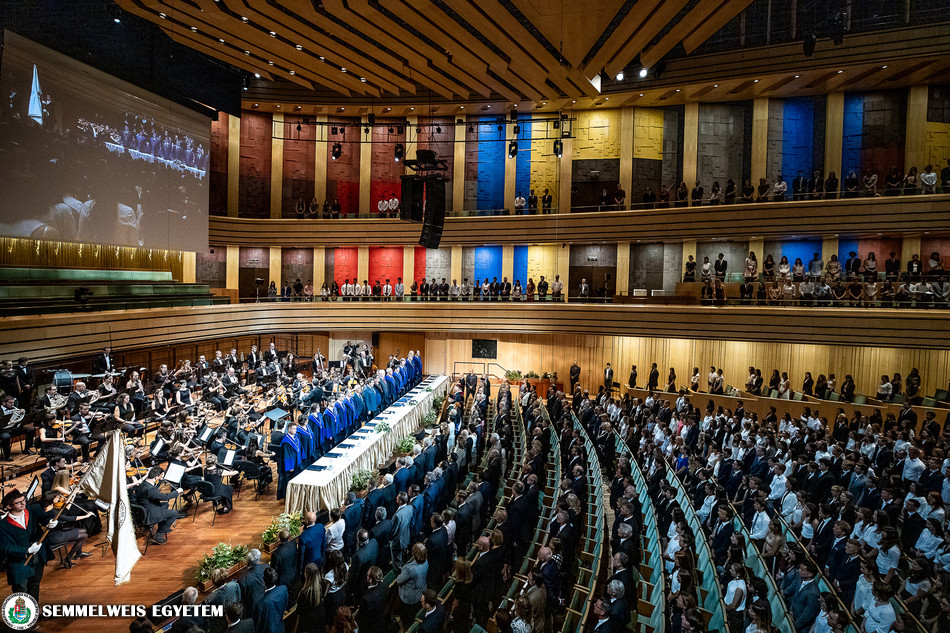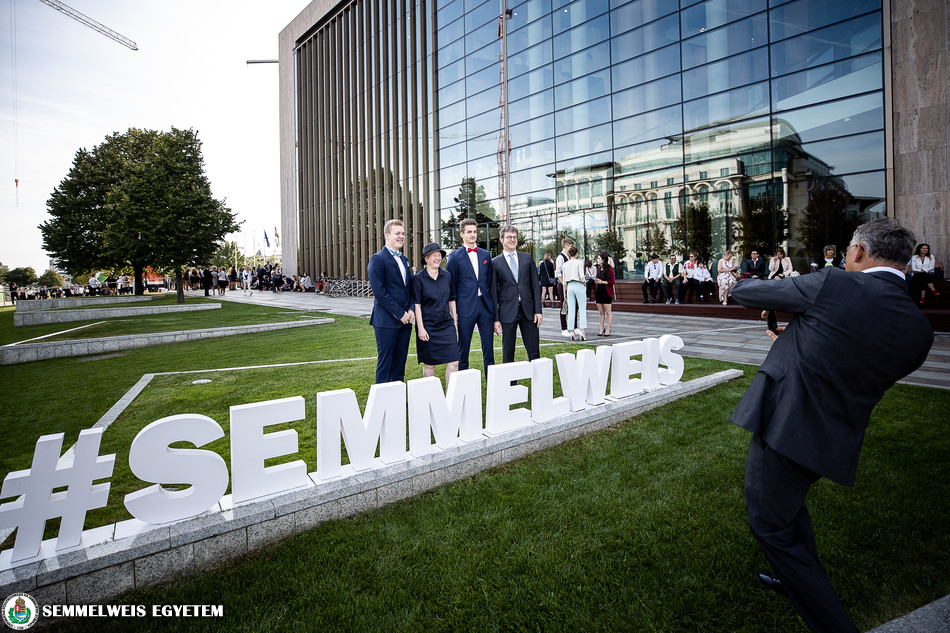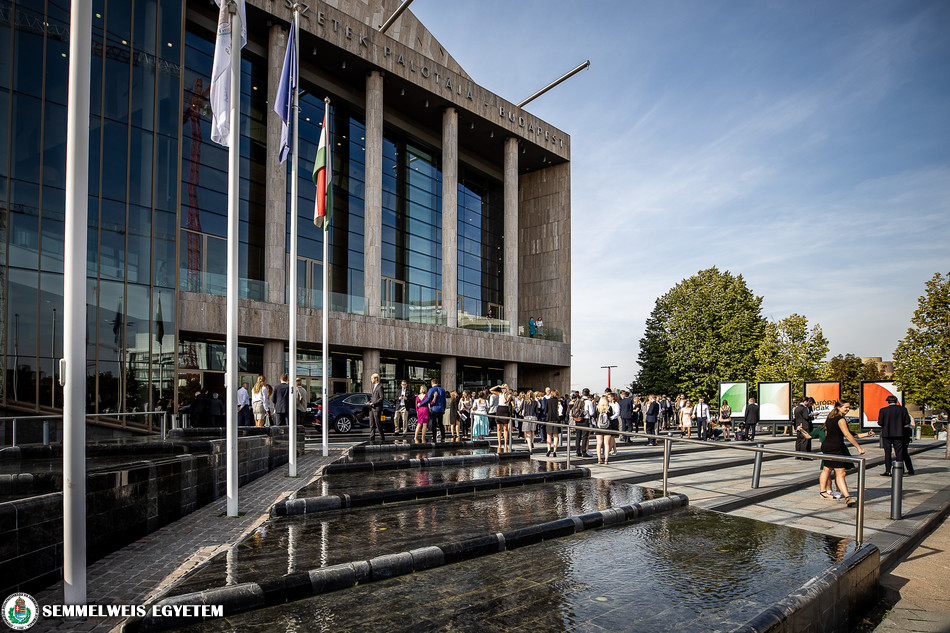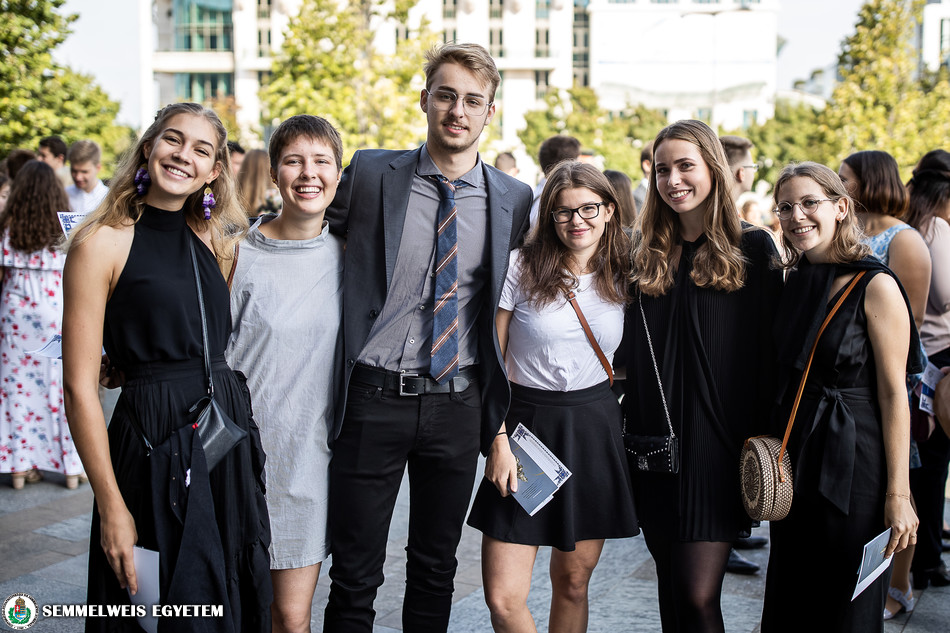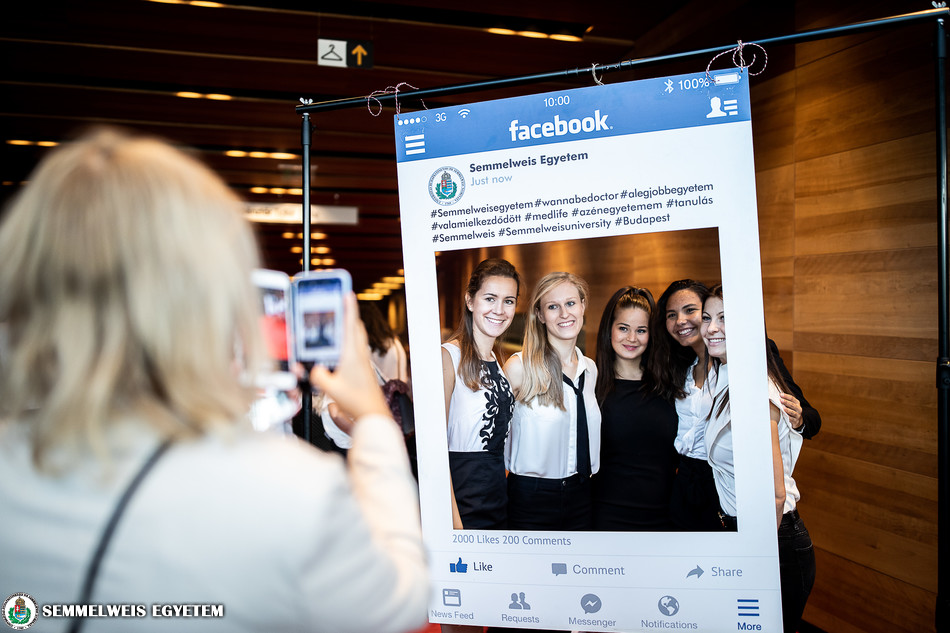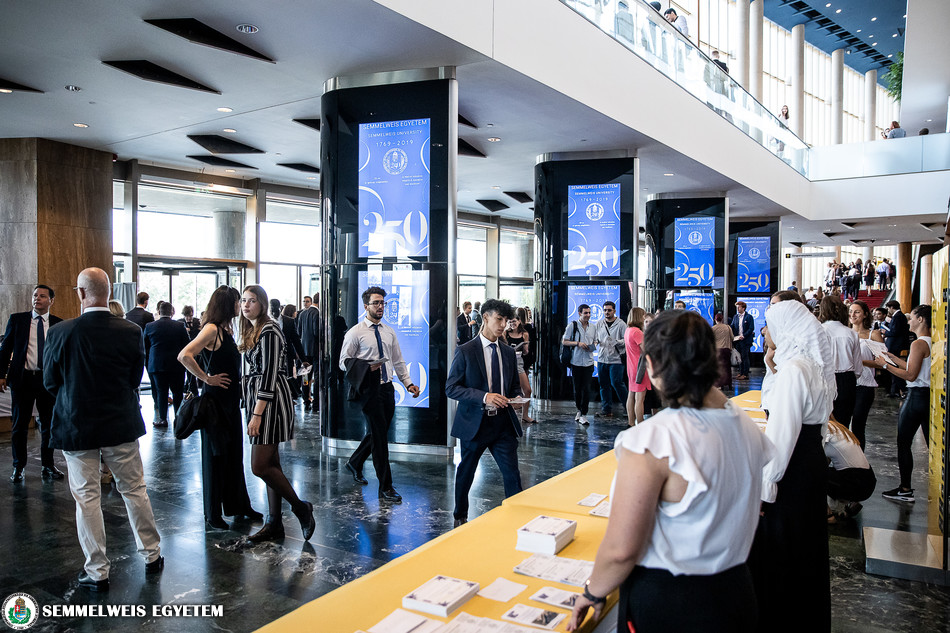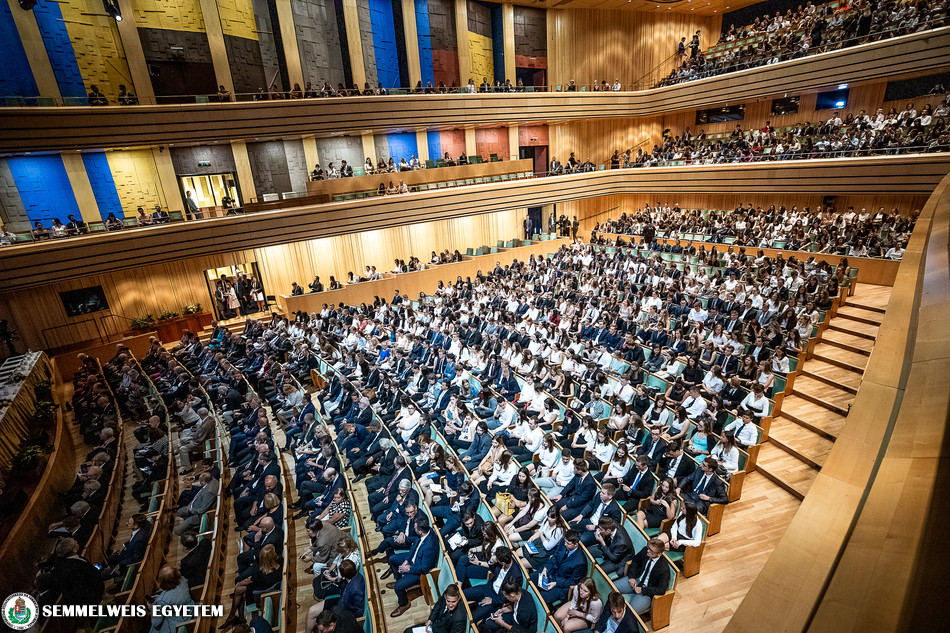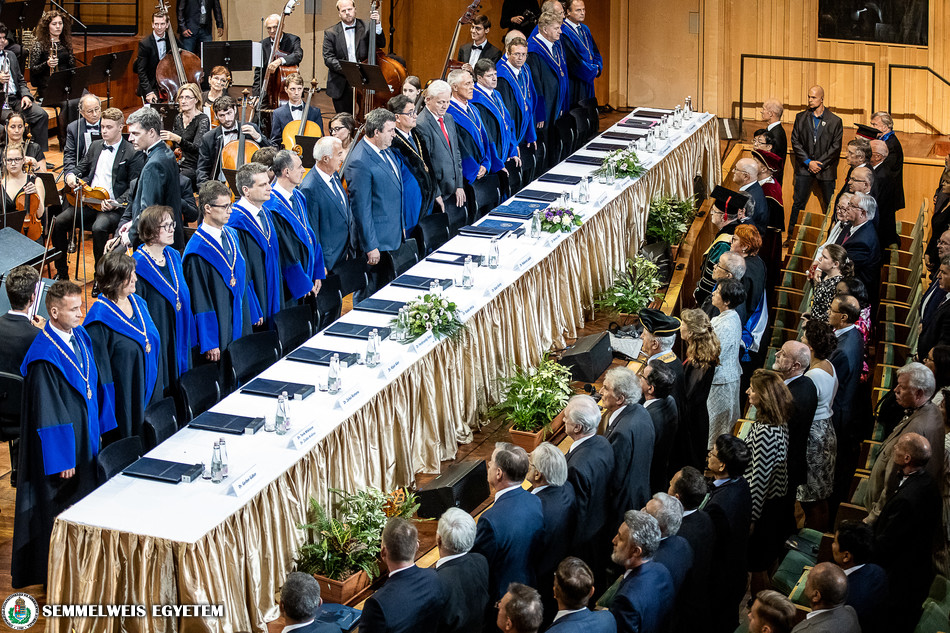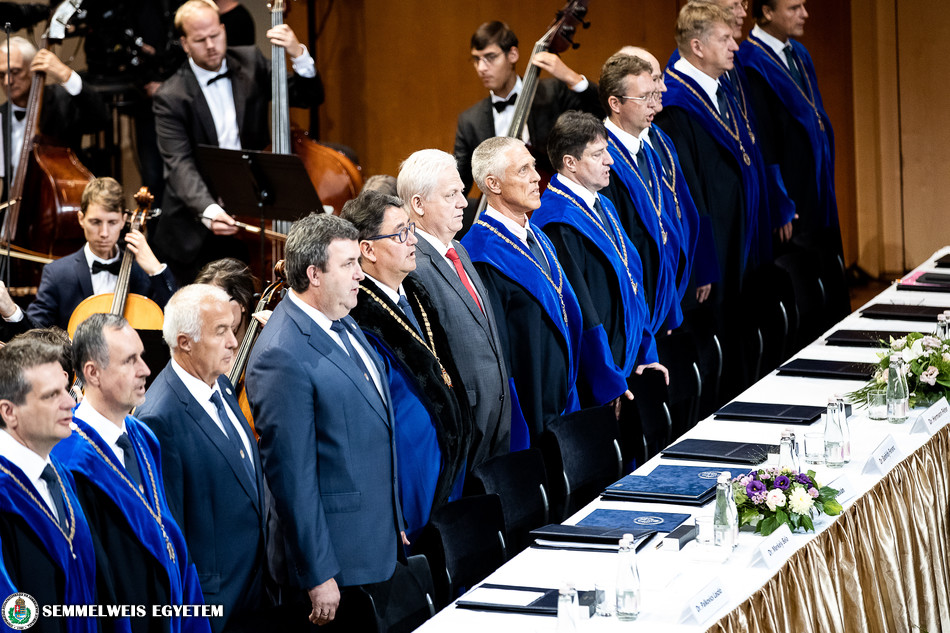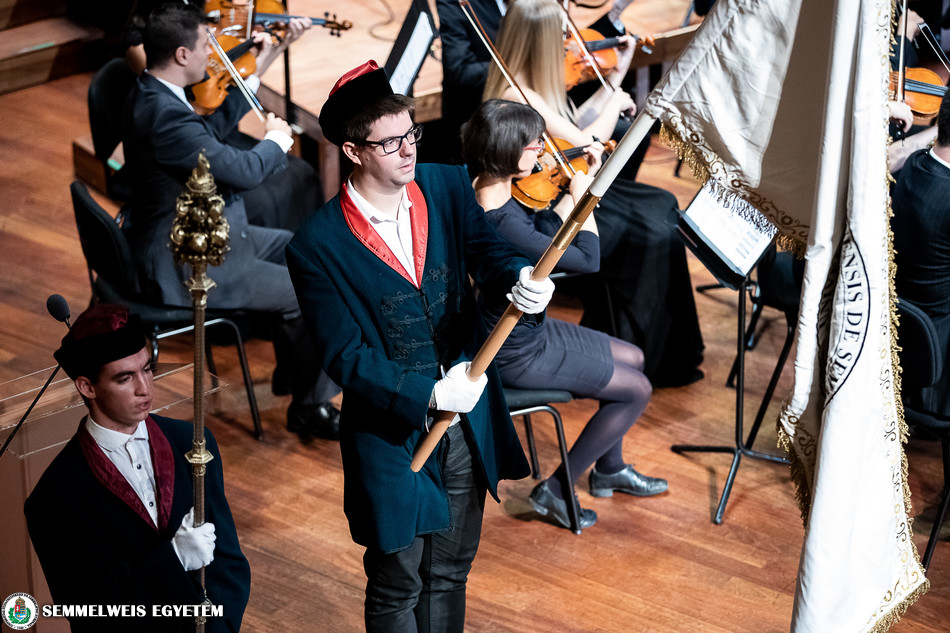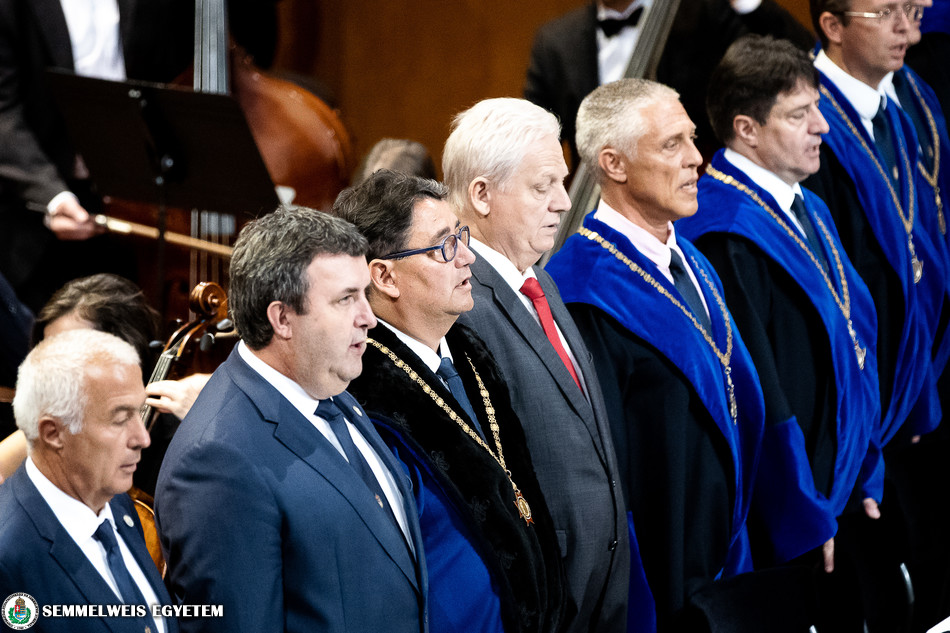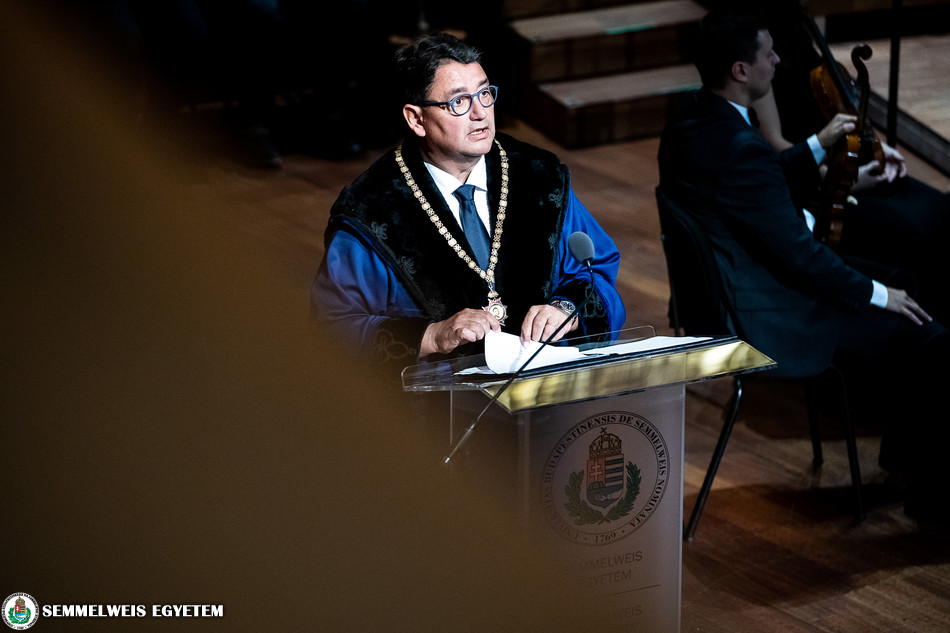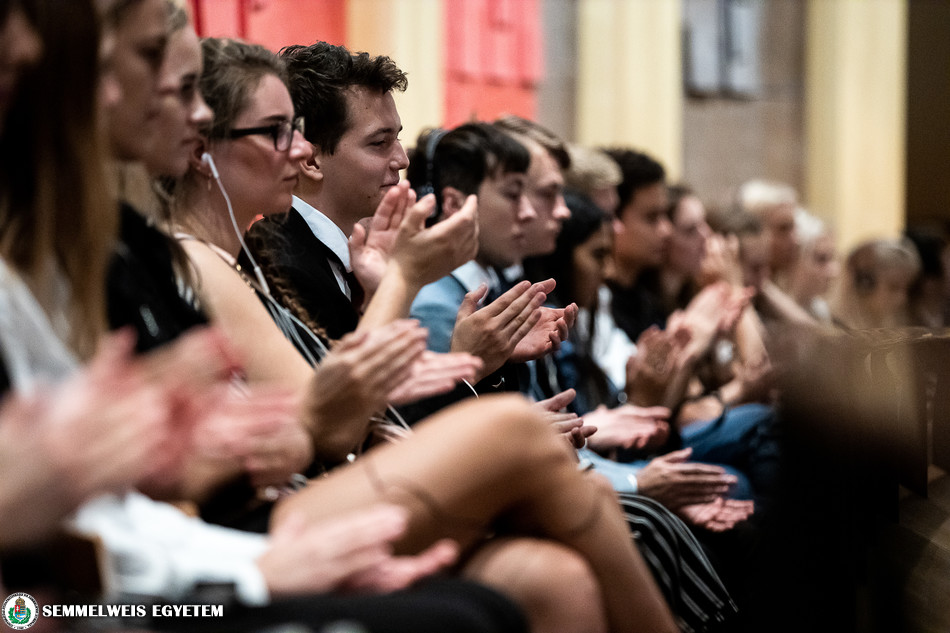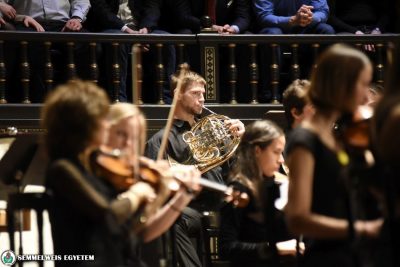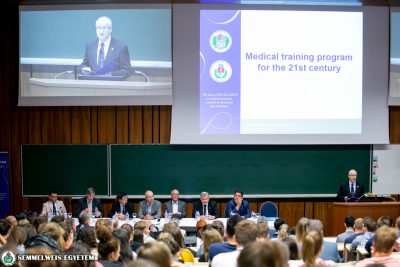“Semmelweis University is a trademark and a brand name that has become a symbol of education, scientific achievements and health care services of the highest quality,” Minister for Innovation and Technology Dr. László Palkovics said in his speech at the opening ceremony of the jubilee academic year. “This is also proven by international rankings that consistently show Semmelweis University ranking at the top among Hungarian universities,” he noted, adding that the public also has a high degree of confidence in the various departments and clinics of the university. Dr. László Palkovics declared this is an excellent foundation to accelerate the university’s further development. “Building on the legacy and foundations of Semmelweis, with the support of the government we will raise the university to a level in line with the requirements of the 21st century under a complex and comprehensive strategic development, the Semmelweis XXI Development Project,” the minister declared. He added that the project launched in January this year as well as the implementation of the higher education development program’s additional elements are necessary to reach the goal of Semmelweis becoming a Top 100 university on a global level. The comprehensive investment will strengthen every element of the trinity of education, research and innovation, and health care, he pointed out.
 “Cooperation between institutions, as well as close collaboration with research networks and companies both in Hungary and abroad are key for raising the quality and competitiveness of education, and for increasing manifold health care and pharmaceutical developments and innovation,” said the minister. He added that in order to increase the competitiveness of the Hungarian economy, the government plans to further develop higher education in the 2018-2022 period working together with the participants of the country’s higher education ecosystem. The goal is to make universities visible on an international level and to strengthen their European cooperation. In order to achieve these goals, operations have to be simplified further, and we have to find the best models of operation, he pointed out.
“Cooperation between institutions, as well as close collaboration with research networks and companies both in Hungary and abroad are key for raising the quality and competitiveness of education, and for increasing manifold health care and pharmaceutical developments and innovation,” said the minister. He added that in order to increase the competitiveness of the Hungarian economy, the government plans to further develop higher education in the 2018-2022 period working together with the participants of the country’s higher education ecosystem. The goal is to make universities visible on an international level and to strengthen their European cooperation. In order to achieve these goals, operations have to be simplified further, and we have to find the best models of operation, he pointed out.
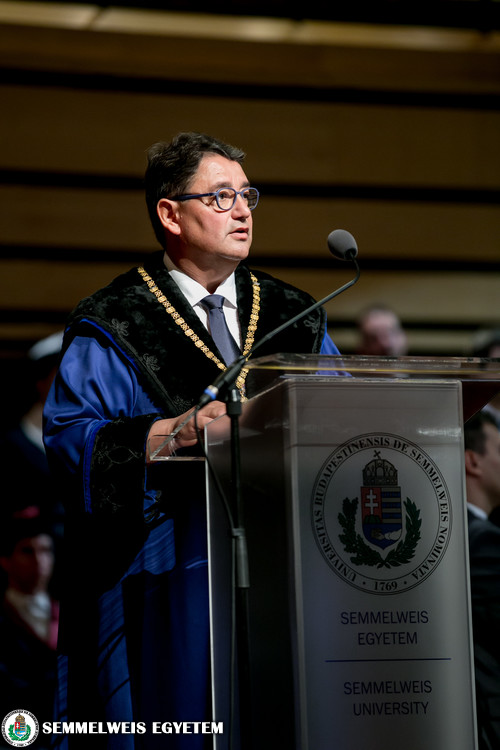 “These are moments of historical significance for medical and health sciences education, research and health care in Hungary and in Europe,” said rector Dr. Béla Merkely in his speech on the opening of the jubilee academic year. He pointed out that in the 2019/20 academic year, we are paying tribute not just to the 250th anniversary of the university’s foundation, but we also celebrate the beginning of organized medical education in Hungary and we take stock of the actions of the doctors and scientists of the past 250 years. Based on their legacy, we are forming the health care of our nation by training the medical doctors, dentists, pharmacists, health care professionals, managers and conductors of the future, presenting them with the health care model of the future, said the rector. He added that we are also bound by the “family tree” of Semmelweis University to this endeavor, this is, the example of such notable individuals as Ignác Semmelweis, Albert Szent-Györgyi, Vilma Hugonnai and Ágost Schoepf-Merei. The rector noted that it was in the course of the past 250 years that the university became what it is today: a renowned institution of higher education both on a national and international level, the proud flagship of medical and health sciences education, innovation and health care, which is attended by 36% of all medical students in Hungary, 35% of all health sciences students and 34% of all international students, with a total student body of almost 12,000.
“These are moments of historical significance for medical and health sciences education, research and health care in Hungary and in Europe,” said rector Dr. Béla Merkely in his speech on the opening of the jubilee academic year. He pointed out that in the 2019/20 academic year, we are paying tribute not just to the 250th anniversary of the university’s foundation, but we also celebrate the beginning of organized medical education in Hungary and we take stock of the actions of the doctors and scientists of the past 250 years. Based on their legacy, we are forming the health care of our nation by training the medical doctors, dentists, pharmacists, health care professionals, managers and conductors of the future, presenting them with the health care model of the future, said the rector. He added that we are also bound by the “family tree” of Semmelweis University to this endeavor, this is, the example of such notable individuals as Ignác Semmelweis, Albert Szent-Györgyi, Vilma Hugonnai and Ágost Schoepf-Merei. The rector noted that it was in the course of the past 250 years that the university became what it is today: a renowned institution of higher education both on a national and international level, the proud flagship of medical and health sciences education, innovation and health care, which is attended by 36% of all medical students in Hungary, 35% of all health sciences students and 34% of all international students, with a total student body of almost 12,000.
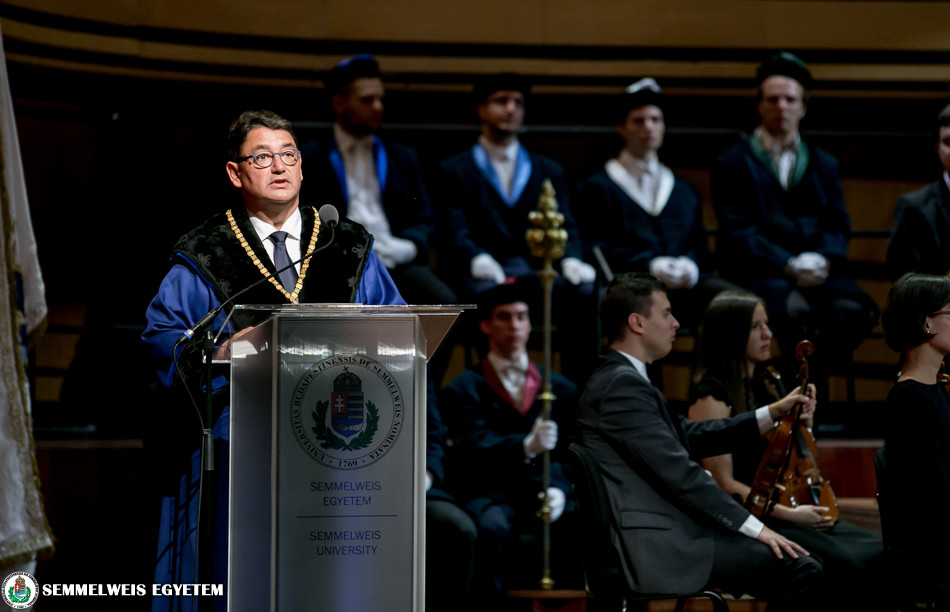 The rector spoke about his primary objective of elevating the university, which thanks to the Semmelweis XXI Development Program stands before huge developments, to among the top 100 in global rankings, and among the top five health care universities of Europe within its field over the next 10 years. He noted that a new curriculum placing practical education in focus will enter into effect with the current jubilee academic year, thus first-year students will already study in this system. He also emphasized that in the jubilee year, the 250-year-old Semmelweis University plans to lead the way in forming attitudes to focus on prevention. “Diseases don’t start in the hospital; we believe in health, and our vocation is health,” he said. We will also strengthen our university’s foreign-language programs, the rector declared, extending a special welcome to international students.
The rector spoke about his primary objective of elevating the university, which thanks to the Semmelweis XXI Development Program stands before huge developments, to among the top 100 in global rankings, and among the top five health care universities of Europe within its field over the next 10 years. He noted that a new curriculum placing practical education in focus will enter into effect with the current jubilee academic year, thus first-year students will already study in this system. He also emphasized that in the jubilee year, the 250-year-old Semmelweis University plans to lead the way in forming attitudes to focus on prevention. “Diseases don’t start in the hospital; we believe in health, and our vocation is health,” he said. We will also strengthen our university’s foreign-language programs, the rector declared, extending a special welcome to international students.
Speaking to the first-year students of the jubilee year, Dr. Béla Merkely stressed that they made the right decision when they chose the university, and the profession of a person who serves and helps others. “It is the love that actively seeks out the benefit and well-being of our patients, those we care for, which is the key of our profession,” he declared. “Be proud that starting from today, you are Semmelweis Citizens,” he told the university’s new students.
“Budapest awaits and welcomes young people who build knowledge,” said Budapest mayor István Tarlós in his speech. The achievements of our great predecessors are an example that tradition, knowledge, humility to the profession and the continuous development that these secure are the foundations of how medical training is conducted, he noted.
 He announced that on the occasion of the 250th anniversary of the establishment of Semmelweis University, the capital and the university decided to renew the cooperation agreement they signed in 2011. The new agreement serves both the advancement of the quality of the capital city and the operations of the university. With its diverse and high-quality know-how and its education methodology, the university will continue on the future to provide aid to the municipal government of Budapest in developing its plans and programs, while the city will support the university with its experience in providing public services, with information and its extensive network of contacts, elaborated István Tarlós. He added that with the renewed agreement, beyond practical cooperation and partnership, Budapest also wants to express its appreciation for Semmelweis University. In honor of the anniversary, the “Klinikák” station of the M3 metro line will also be renamed “Semmelweis University – Klinikák.”
He announced that on the occasion of the 250th anniversary of the establishment of Semmelweis University, the capital and the university decided to renew the cooperation agreement they signed in 2011. The new agreement serves both the advancement of the quality of the capital city and the operations of the university. With its diverse and high-quality know-how and its education methodology, the university will continue on the future to provide aid to the municipal government of Budapest in developing its plans and programs, while the city will support the university with its experience in providing public services, with information and its extensive network of contacts, elaborated István Tarlós. He added that with the renewed agreement, beyond practical cooperation and partnership, Budapest also wants to express its appreciation for Semmelweis University. In honor of the anniversary, the “Klinikák” station of the M3 metro line will also be renamed “Semmelweis University – Klinikák.”
Dr. István Tarlós and Dr. Béla Merkely proceeded to sign the cooperation agreement at the opening ceremony.
The speeches were followed by the students taking their solemn oath in three languages: Hungarian, English and German.
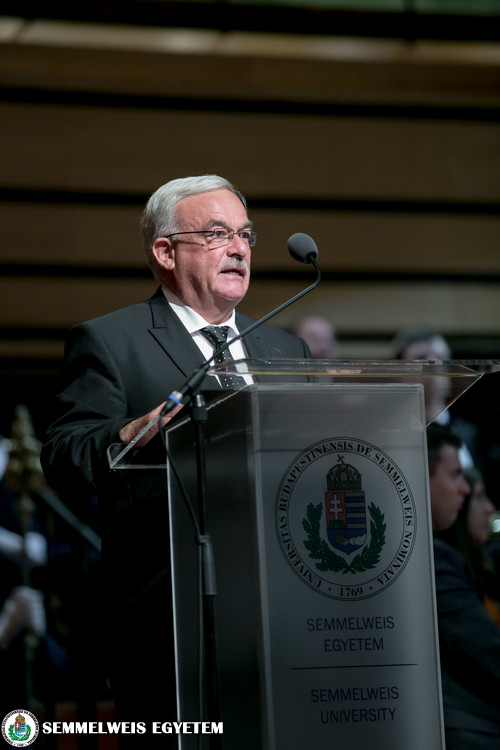 Next to speak was Béla Kató, the leader of the Transylvanian Reformed Church District, who, referring to the off-campus program of the András Pető Faculty located in Illyefalva (Ilieni) in the Romanian county of Covasna, thanked all those who have taken upon themselves to teach in Hungarian in these – as he called them – distant regions. “After 250 years, we can all be grateful that Hungarian medical training in higher education has been present for two and a half centuries now. We, Hungarians living in Transylvania, now also give thanks that during the first 150 of these 250 years, we marched together and lived through all the struggles and joys of creating an institution. But we are also grateful that over these last 100 years, albeit at heroic efforts, but there is still Hungarian medical training in Transylvania, in Marosvásárhely [Targu Mures, Romania],” said Béla Kató, the leader of the Transylvanian Reformed Church District. Referring to the off-campus program of the András Pető Faculty located in Illyefalva (Ilieni) in the Romanian county of Covasna, he thanked all those who have taken upon themselves to teach in Hungarian in these – as he called them – distant regions. He pointed out to students that as a first step, health care requires creating a climate of trust where patients can make the decision that they want to live and get better.
Next to speak was Béla Kató, the leader of the Transylvanian Reformed Church District, who, referring to the off-campus program of the András Pető Faculty located in Illyefalva (Ilieni) in the Romanian county of Covasna, thanked all those who have taken upon themselves to teach in Hungarian in these – as he called them – distant regions. “After 250 years, we can all be grateful that Hungarian medical training in higher education has been present for two and a half centuries now. We, Hungarians living in Transylvania, now also give thanks that during the first 150 of these 250 years, we marched together and lived through all the struggles and joys of creating an institution. But we are also grateful that over these last 100 years, albeit at heroic efforts, but there is still Hungarian medical training in Transylvania, in Marosvásárhely [Targu Mures, Romania],” said Béla Kató, the leader of the Transylvanian Reformed Church District. Referring to the off-campus program of the András Pető Faculty located in Illyefalva (Ilieni) in the Romanian county of Covasna, he thanked all those who have taken upon themselves to teach in Hungarian in these – as he called them – distant regions. He pointed out to students that as a first step, health care requires creating a climate of trust where patients can make the decision that they want to live and get better.
 Speaking on behalf of the Students’ Union, president Tamás Hegedüs greeted the newly enrolled students. He urged the freshman class to believe in themselves and that as a community, helping each other, they can overcome even the most difficult tasks. He emphasized that new students have been accepted to one of the best universities in Europe, where a paradigm shift has just started which is based on practice-oriented education that focuses on the patient, and a student-friendly attitude, mixed with a respect for the traditions of the past.
Speaking on behalf of the Students’ Union, president Tamás Hegedüs greeted the newly enrolled students. He urged the freshman class to believe in themselves and that as a community, helping each other, they can overcome even the most difficult tasks. He emphasized that new students have been accepted to one of the best universities in Europe, where a paradigm shift has just started which is based on practice-oriented education that focuses on the patient, and a student-friendly attitude, mixed with a respect for the traditions of the past.
At the ceremony, Dr. Béla Merkely presented Dr. Szabolcs Szuromi, the outgoing rector of the Pázmány Péter Catholic University, with a Pro Universitate Award. The list of students who won the National Higher Education Scholarship was announced.
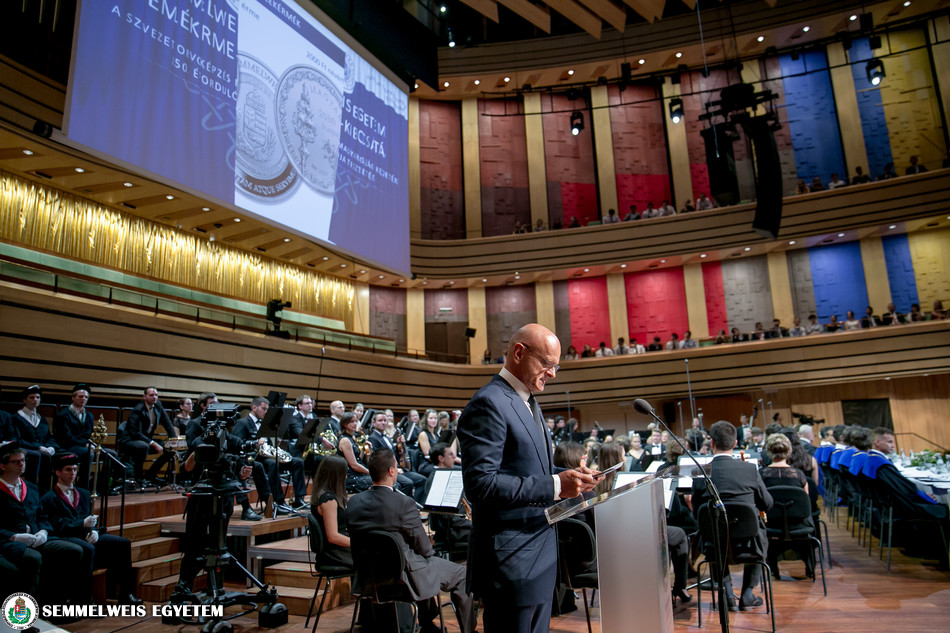 On the occasion of the 250th anniversary of the foundation of Semmelweis University, the National Bank of Hungary (MNB) has issued silver and base metal commemorative coins, which it presented at the event. Dr. Mihály Patai, the deputy-governor of MNB, said that the HUF 10,000 denomination silver commemorative coin, and its HUF 2000 version base metal version, were designed by sculptor Virág Szabó. The commemorative coins are considered legal tender, similar to the coins in circulation, but their primary purpose is raising awareness for this anniversary of historical significance and the recognition of the high quality of education, research and health care being conducted at the university, the deputy-governor noted. The commemorative coins are being issued in a limited number, with a maximum of 5000 pieces each to be issued.
On the occasion of the 250th anniversary of the foundation of Semmelweis University, the National Bank of Hungary (MNB) has issued silver and base metal commemorative coins, which it presented at the event. Dr. Mihály Patai, the deputy-governor of MNB, said that the HUF 10,000 denomination silver commemorative coin, and its HUF 2000 version base metal version, were designed by sculptor Virág Szabó. The commemorative coins are considered legal tender, similar to the coins in circulation, but their primary purpose is raising awareness for this anniversary of historical significance and the recognition of the high quality of education, research and health care being conducted at the university, the deputy-governor noted. The commemorative coins are being issued in a limited number, with a maximum of 5000 pieces each to be issued.
Dr. Mihály Patai presented the first complimentary pieces of the coins to Dr. László Palkovics, István Tarlós, Dr. Béla Merkely, chancellor Dr. Károly Szász, as well as to designer Virág Szabó and Eszter Kovács, the director of the university’s communication department and the thematic expert of the commemorative coins.
The closing act of the ceremony was a performance of Johannes Brahms’ Academic Festival Overture by the Medic Orchestra.
In tribute to the university’s 250 years of tradition, at the opening ceremony of the jubilee academic year the original, historical regalia of office were used. Students took their solemn oaths by placing their hands on the original sceptre made in 1772 for the medical faculty of the university’s legal predecessor, the University of Nagyszombat, while the rector wore the chain of office that was presented by Francis I in 1819 to the university upon its move to Pest.
On the occasion of the special anniversary, students were also welcomed by various programs at the event, including information desks, a sandwich luncheon and background music provided by the Students’ Union. Following the opening ceremony, new students formed a live tableau of the number 250 in front of the MÜPA building. The university’s “Letters for the future” initiative was also launched at the opening ceremony, under which messages can be sent to the Semmelweis Citizens of the future. Collection boxes for these letters will be placed at various events during the 10-month series of program during the anniversary year. The collected letters are to be opened 50 years from now, at the university’s 300th anniversary.
A total of 3302 first-year students are beginning their studies in the 2019/20 academic year at the university’s six faculties, including 875 studying in the English and German-language programs.
For more pictures, click over to our Hungarian article on the opening ceremony.
Pálma Dobozi
Translation: Tamás Deme
Photo: Zoltán Adrián; Attila Kovács – Semmelweis University
